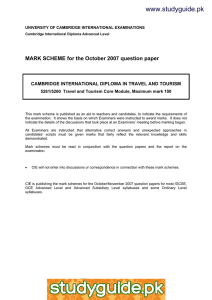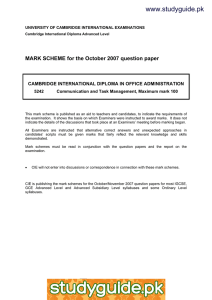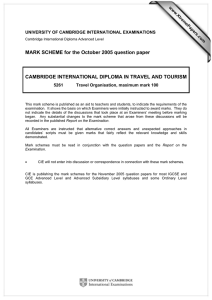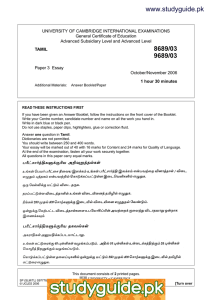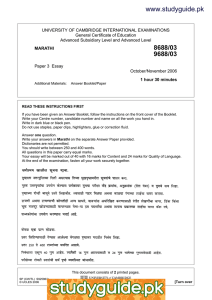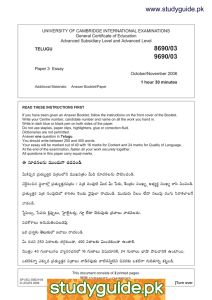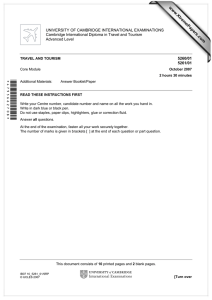MARK SCHEME for the October 2007 question paper www.XtremePapers.com
advertisement
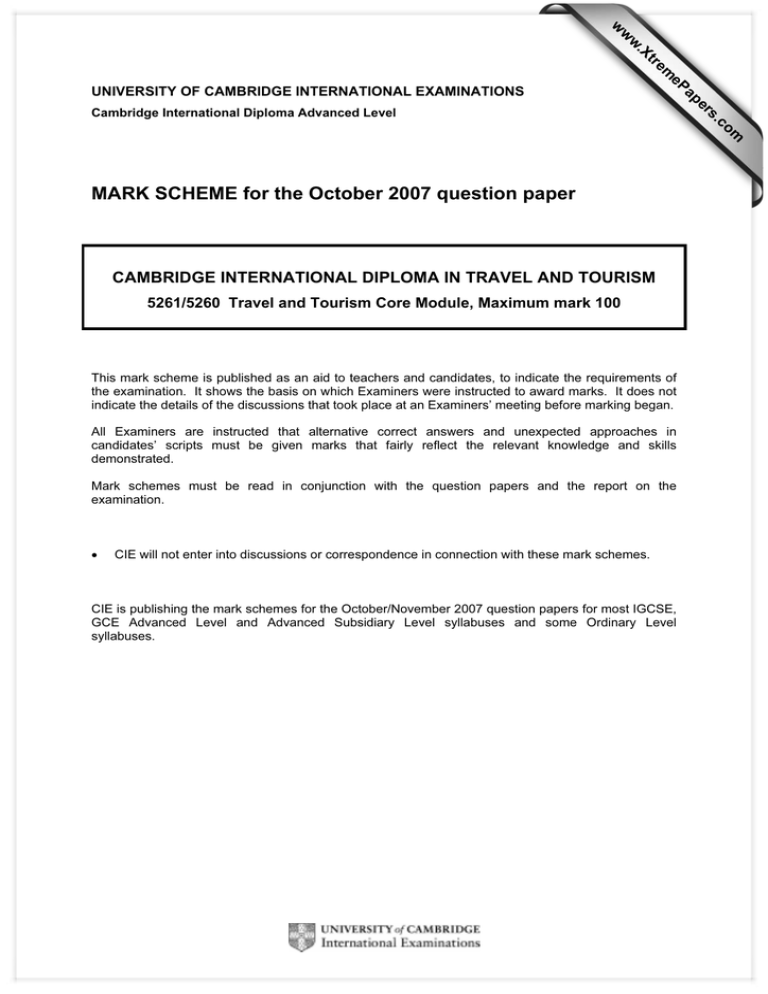
w w ap eP m e tr .X w UNIVERSITY OF CAMBRIDGE INTERNATIONAL EXAMINATIONS om .c s er Cambridge International Diploma Advanced Level MARK SCHEME for the October 2007 question paper CAMBRIDGE INTERNATIONAL DIPLOMA IN TRAVEL AND TOURISM 5261/5260 Travel and Tourism Core Module, Maximum mark 100 This mark scheme is published as an aid to teachers and candidates, to indicate the requirements of the examination. It shows the basis on which Examiners were instructed to award marks. It does not indicate the details of the discussions that took place at an Examiners’ meeting before marking began. All Examiners are instructed that alternative correct answers and unexpected approaches in candidates’ scripts must be given marks that fairly reflect the relevant knowledge and skills demonstrated. Mark schemes must be read in conjunction with the question papers and the report on the examination. • CIE will not enter into discussions or correspondence in connection with these mark schemes. CIE is publishing the mark schemes for the October/November 2007 question papers for most IGCSE, GCE Advanced Level and Advanced Subsidiary Level syllabuses and some Ordinary Level syllabuses. Page 2 1 Mark Scheme Cambridge International Diploma – October 2007 Syllabus 5261/5260 (a) The Nepal Tourism Board (NTB) is a national organisation whose aims are to: • • • • • be responsible for the marketing activities aimed at promoting Nepal as a premier destination to take over regulatory and product development activities provide leadership continue with promotional methods offer good management and guidance Each of the above to be identified 1 mark and brief explanation 1 further mark. Generic objectives not accepted, answers must relate to the passage. NOT accepted – preserving age old culture 2x2 [4] A4.0 (b) Strategies can include any of the following: • • • • positioning the image of the country to gain worldwide recognition and increase visitor numbers to market and promote Nepal aggressively, this again will raise the profile of the country and encourage tourism to make Nepal the most premier holiday destination to increase foreign currency earnings to collect a tourist service fee which will help towards development of the infrastructure The strategy must be from the case study and marketing strategies are NOT accepted in this context. 2 + 2 for any of the above [4] A1.0 A3.0 (c) (i) The economy of Nepal would have been affected by the following impacts: • • • • • decrease in visitor arrivals leads to loss of income loss of income leads to loss of jobs lack of multiplier effect loss of foreign currency earnings loss of investment opportunities Any reasonable impact identified 1 mark and explanation given up to 2 further marks. [3] A2.0 (ii) The infrastructure would have been affected due to: • • • lack of ongoing or future investment lack of GDP leading to lack of future planning grants, loans and financial assistance lacking due to fall in numbers Any reasonable impact identified 1 mark and explanation given up to 2 further marks. [3] A2.0 © UCLES 2007 Page 3 Mark Scheme Cambridge International Diploma – October 2007 Syllabus 5261/5260 (d) Level of Response This question is based on extensive material in the case study and candidates are expected to maximise the use of this to formulate a reasoned response to their answer. Cultural tourism attracts visitors and the article refers to Nepal expecting 100.000 visitors from all over the world. The benefits of increased visitor spending together with the benefits in preserving local arts, crafts, customs and traditions should be discussed. National pride and identity and the link to sustainable tourism should be addressed for the higher marks. Level 1 1–4 A2.0 Brief statements with little use of case study and lacking in understanding of the range of benefits. Candidates will identify points and may not make reference to sustaining tourism. Level 2 5–8 A3.0 Description of the benefits of maintaining culture and tradition with some explanation of the benefits and reference to sustainable tourism Level 3 9–10 A4.0 In depth response with analytical comments and clear understanding of the link between preservation of culture and sustainable tourism (e) This question is looking for candidates’ ability to refer to any global event – natural or man-made e.g. war, devaluation of currency, hurricane, tsunami, bird flu, earthquake etc. They should be able to describe the event (2 marks) and give a reasoned explanation of the impacts caused at the named destination (Further 2 marks). Analysis given further 2 marks total 6 [6] A2.0 2 (a) • • • • To disseminate correct and reliable information about Nepal's tourism. To recognise the media's role in influencing public opinion throughout the world (increase awareness) The media centre aims to facilitate Nepal based foreign journalists as well as national media community by disseminating accurate information related to Nepalese tourism products and activities. This centre also plays an active role by interacting with the international media in promoting Nepal and its image as premier destination. Use of the above taken from case study or additional marketing and promotional statements credited up to 2 marks each, 2 + 2 [4] B1.0 (b) Any reasonable method of sales promotion in context acceptable e.g. • Free gifts • Competitions • POS materials • Use of techniques such as beautifully decorated pavilion • Decorated with Nepalese attractions 1 mark for method + 1 further mark for expansion of use, 2 + 2 © UCLES 2007 [4] B2.0 Page 4 Mark Scheme Cambridge International Diploma – October 2007 Syllabus 5261/5260 (c) Three objectives of public relations are: • • • • • • To disseminate the positive news about Nepal To launch new products To remind and re-position existing products To generate interest To influence specific target groups To promote a favourable image 1 mark for objective + 1 further mark for expansion 3 x 2 (d) (i) Call free Internet Freepost 3x1 [6] B2.0 [3] B3.0 B2.0 (ii) Developing or attacking accepted [1] B3.0 (e) Level of Response Candidates should be able to recognise the wealth of market research available from this advert and be able to analyse and evaluate its effectiveness. Saga holidays will be able to identify the most popular areas and develop their marketing strategies further. They will also know the geographic and demographics of the respondents to enable further direct marketing. They will be able to create a database for further mail shots, and they will also know from the code at the bottom of the advert which publication the reader saw the advert [8] B3.0 Level 1 1–3 Brief statements that identify methods with limited reference to the advert Level 2 4–6 Use of methods explained with attempt at evaluation of at least two methods Level 3 7–8 A developed answer with good use of advert and clear evaluation of the information used by Saga holidays © UCLES 2007 Page 5 3 Mark Scheme Cambridge International Diploma – October 2007 Syllabus 5261/5260 (a) Three major factors that may account for the popularity of purpose built destinations are any from: • • • • • • Increase in leisure time Increase in disposable income All facilities and amenities provided in one area Increase in popularity of theme resorts All references to the factors directly in context with Sun City accepted Any reasonable factor explained 1 mark for identification + 1 further mark for expansion x 3 [6] C1.0 (b) • Because of the location of major holiday destinations outside of South Africa it may be too far to travel • Affordability to take families etc. out of Africa to more well known destinations • The resort offers something for everyone • There are no political restrictions on travel • The resort has luxury hotels close to a National park • The resort offers major events such as live shows and golf tournaments 1+1x2 [4] C2.0 (c) Sun City needs to attract different markets for any of the following: • • • • • Maximise business opportunities Operate all year round Minimise impacts on services and facilities Attract leisure and business visitors to raise profile ‘Word of mouth’ recommendations from different groups help to promote the destination Any other reasonable answer accepted, 1 + 3 or 2 + 2 One or more reasons may be given and marks awarded as above. [4] C3.0 (d) The private sector is obviously a majority stakeholder in the success of the destination. Through the provision of its facilities such as accommodation, attractions, transport, entertainment and business related facilities it is able to provide employment opportunities, training and investment. It can also provide increased visitor numbers through marketing and promotion as well as the services of travel agents and tour operators to sell the destination. Award marks for suitable explanation of 1 or more roles of the private sector [4] C4.0 © UCLES 2007 Page 6 Mark Scheme Cambridge International Diploma – October 2007 Syllabus 5261/5260 (e) Level of Response Level 1 1 – 2 Brief statements which identify successful tourism management Level 2 3 – 4 Use of examples from case study explained in context. Level 3 5 -6 Evaluation of characteristics given from case study C5.0 4 (a) (i) Tourism Concern – voluntary sector [1] C4.0 (ii) Aims are to represent the views of its members in all matters concerning protection of the environment, local cultures and traditions. They get their funding through donations and membership fees and the sale of promotional material. 1 x 2 for aims + 1 for funding or v.v. [3] C4.0 (b) Two negative socio-cultural impacts may be: • • • • • • loss of water supplies may cause disease through lack of adequate sanitations limited development of infrastructure for locals e.g. housing, roads, schools etc conflict may arise through overcrowding and lack of opportunity family businesses e.g. fishing may be at risk demonstration effect conflict between hosts and tourists Any reasonable impact given with understanding and in context. 2 x 2 [4] A2.0 (c) The benefits of a triangular relationship must be identified between the • • • • host population developers local and national government tourists, sectors and environment Each sector must be given to gain maximum marks. Benefits include negotiation, employment and training, protection of the environment, spread of wealth, enhancement of local conditions and any other reasonable benefit given in context. Up to 2 marks for each sector x 3 [6] A3.0 A4.0 © UCLES 2007 Page 7 Mark Scheme Cambridge International Diploma – October 2007 Syllabus 5261/5260 (d) Level of Response This question is seeking to find out if the candidates are able to respond to the information given in the case study and to evaluate the impacts on the environment. These are mainly the effects of the destruction of the mangrove swamps and its impact on the local marine life, dolphins and turtles. It also has an effect on the protection of the land, e.g. an example is given about the threat of tsunami and hurricane if the mangroves are no longer there to protect the land, L1 – Brief statements 1–2 L2 – Explanation of impacts 3–4 L3 – Evaluation of impacts 5–6 A2.0 © UCLES 2007
